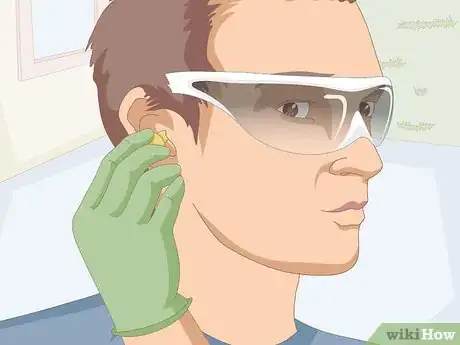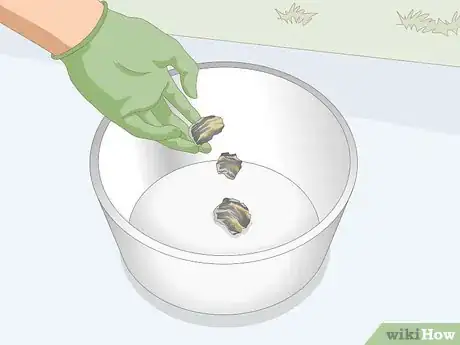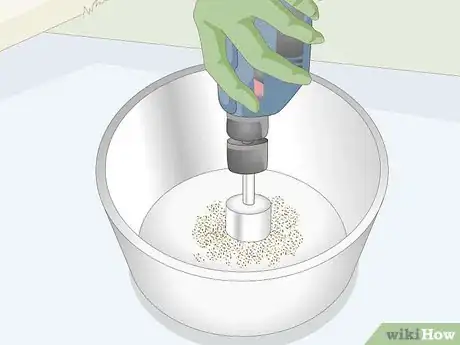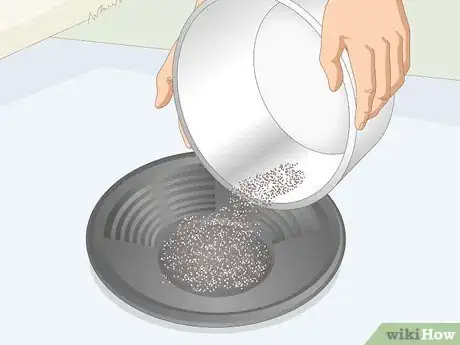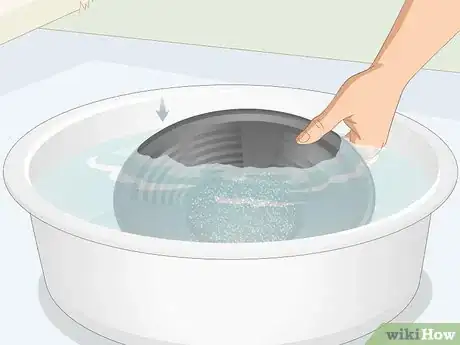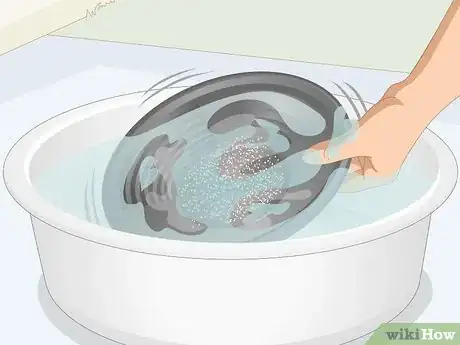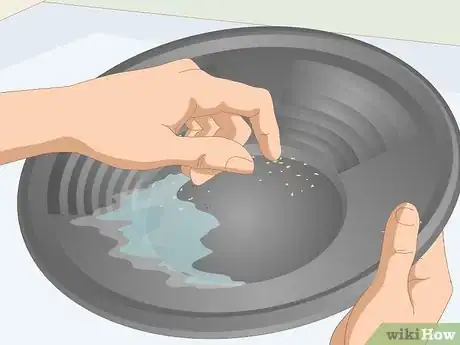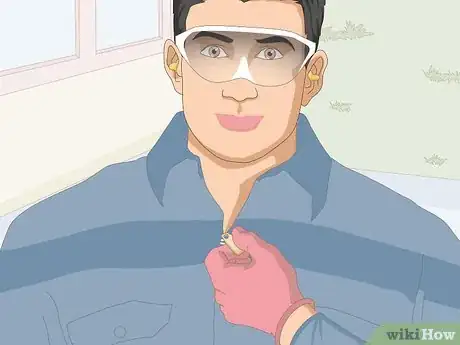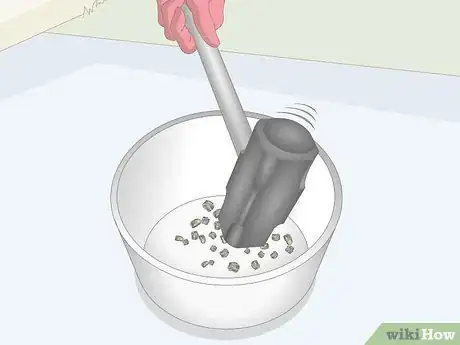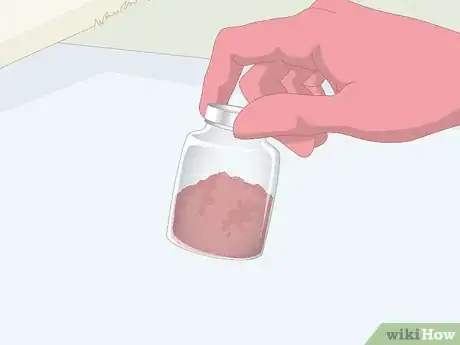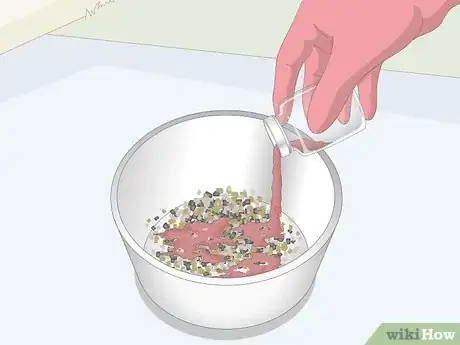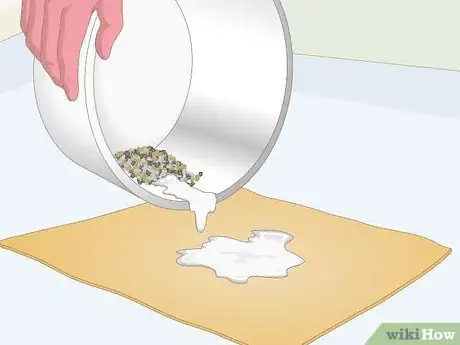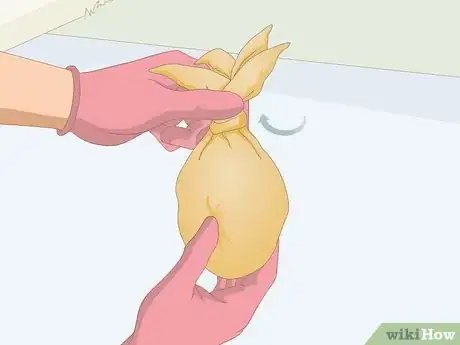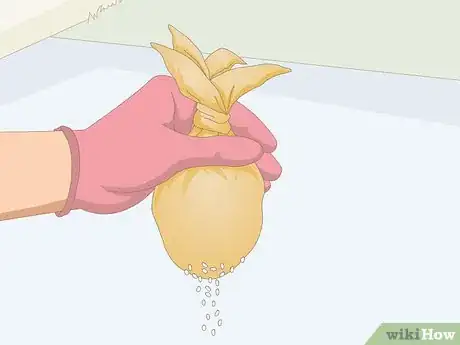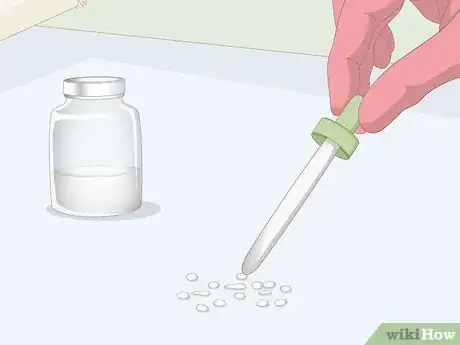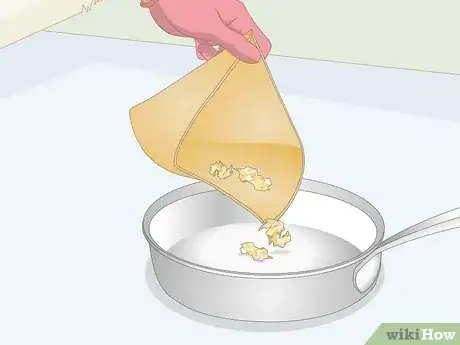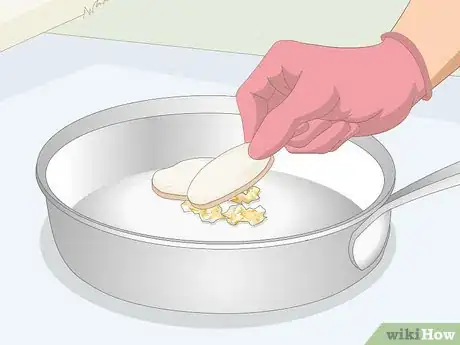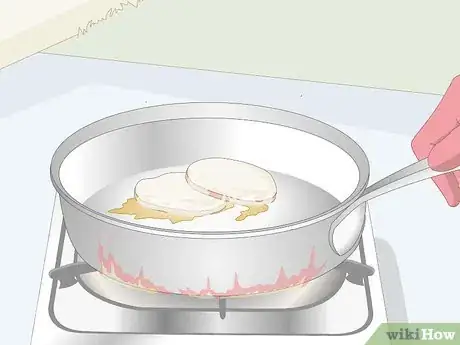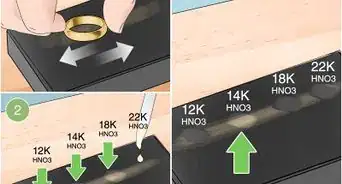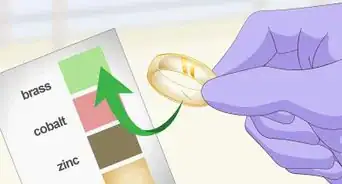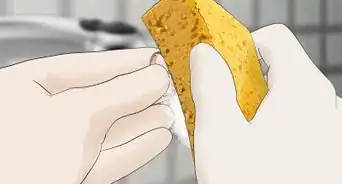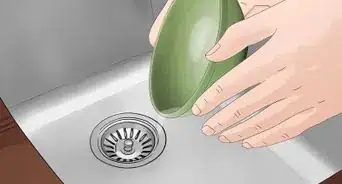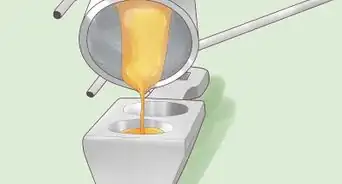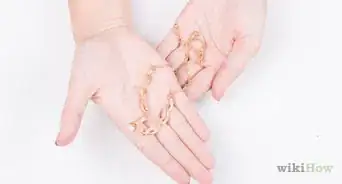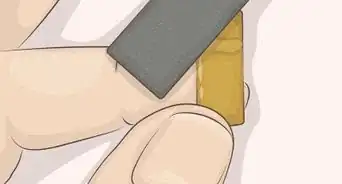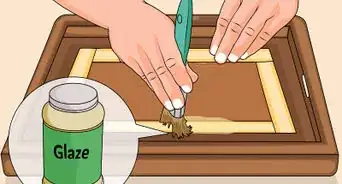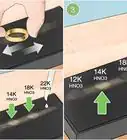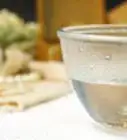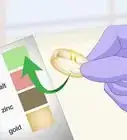This article was co-authored by wikiHow staff writer, Danielle Blinka, MA, MPA. Danielle Blinka is a Writer, Editor, Podcaster, Improv Performer, and Artist currently living in Houston, TX. She also has experience teaching English and writing to others. Danielle holds a Bachelor of Arts in English, Bachelor of Arts in Political Science, Master of Arts in English with a concentration in writing, and Master of Public Administration from Lamar University.
There are 8 references cited in this article, which can be found at the bottom of the page.
This article has been viewed 81,165 times.
Learn more...
Prospecting for gold can be a fun hobby, though it’s a lot of work! You may be able to harvest gold flakes from rock if it contains gold among its minerals. The safest way to extract gold from rocks at home is to crush the rocks. However, you might use mercury to extract the gold if you’re able to obtain some, though this is dangerous. While both mercury and cyanide can be used to extract gold from rock, it's hazardous to both your health and the environment to use them.[1]
Steps
Crushing Rocks to Extract Gold
-
1Put on your gloves, ear plugs, and protective eye wear. Crushing rocks can be very dangerous, so put on protective gear. Wear thick work gloves to protect your hands from blisters and cuts, and use ear plugs to protect your hearing. Cover your eyes with safety glasses in case a piece of rock flies up into your face.[2]
- Striking the rock can be very loud, so it might damage your hearing. If you’re using a machine, it’ll be especially loud.
-
2Put the rocks in a metal container. Metal works best for crushing rock because you'll be striking them hard with a blunt instrument. Pick an old metal container that you don’t mind damaging. Place 1 or more rocks inside the container in a single layer.[3]
- Don’t try to crush too many rocks at one time. If you layer the rocks, it'll be too difficult to crush them.
Did You Know? You can extract gold from quartz rock that contains veins of gold. However, you’ll need to crush the quartz to access the gold.
Advertisement -
3Use a sledgehammer to break the rock into smaller pieces. Lift the sledgehammer into the air, then swing it down onto the rock as hard as you can. Strike the rocks with your hammer until they’re crushed into small pebbles.[4]
- If you have access to a power hammer, use it to break up your rock faster and easier.
- You can also drop a heavy object, like a weight, onto the rocks. However, this might be less efficient.
- Historically, gold prospectors used sledgehammers to break up rock.
Variation: The best way to crush the rocks is to use a crushing machine, which will produce a fine powder with little effort on your part. Consider purchasing a rock crusher designed for extracting gold if you’re serious about prospecting.[5]
-
4Grind the rock into a powder using a metal rod. Leave your rock pebbles in the metal container for the grinding process. Use a metal rod with the metal container to create a makeshift mortar and pestle that are strong enough to use with rocks. Press the end of the metal rod into the rock pebbles, then drag the rod along the bottom and sides of the metal container. Grind the rocks until the pieces are slightly larger than the holes in the bottom of your mining pan.[6]
- Historic gold miners used a mortar and pestle to grind up rocks. With persistence, you can turn the rocks into powder.
-
5Put the rock powder in a mining pan. A mining pan has holes in the bottom of it like a colander. Because gold is heavy, it will sink to the bottom of the mining pan even while it's submerged in water, while the other minerals wash away. Pour a layer of rock powder onto the mining pan so you can extract the gold pieces.[7]
- You can find a mining pan online.
-
6Submerge the mining pan in a container of water. Use a container that's larger than your mining pan. Fill the container with water and set it on a level surface where you feel comfortable working. Then, grasp the sides of the mining pan and push it down into the water.[8]
- Some of the powder will start to float away, which is totally okay!
-
7Shake the container until the gold is exposed at the bottom of the pan. While still holding the pan under the water, gently shake it to shift the rock powder. Expect the particles that aren’t gold to float away and mix into the water.[9]
- Gold is heavier than other minerals, so it will settle at the bottom of the mining pan.
-
8Check the mining pan periodically to see if the gold is extracted. Pull the mining pan out of the water and look at the pieces that remain in the pan. Pick out any gold pieces and place them in a separate container. Continue to shake the mining pan in the water until you’ve picked out all of the gold pieces.[10]
Extracting the Gold with Mercury
-
1Wear protective clothing, gloves, ear plugs, and eye wear. Mercury is very dangerous, so put on your protective gear before you try to extract gold. Wear long pants, long sleeves, closed-toed shoes, and thick work gloves. Additionally, put on protective eye wear so that rock bits and mercury don’t get into your eyes. While you’re crushing the rock, wear ear plugs to protect your hearing.[11]
- If you have an industrial jumpsuit, wear it to provide you more protection.
-
2Crush your rock into a powder using a sledgehammer. Put the rock in a metal container, then swing a sledgehammer down onto it. Continue to strike the rock with your sledgehammer until it’s broken up into small, pebble-sized pieces.[12]
- You don’t need to grind your pebbles into a powder when you’re using mercury sulfide (HgS) to extract the gold.
-
3Obtain mercury sulfide (HgS) as cinnabar to use for gold extraction. Cinnabar is naturally occurring mercury sulfide (HgS), so you may be able to harvest it. If you can’t harvest it, purchase it online. While the cinnabar is nontoxic, it will become toxic during the extraction process.[13]
- You may be able to harvest your own cinnabar if you live in Spain, Egypt, the United States, New Zealand, the Philippines, Slovenia, Italy, Serbia, Peru, and China. Do an online search to find a mining site in your area. Typically, it's present in rock formations around hot springs. If it's legal for you to harvest your own cinnabar, use a pickax to chisel off a piece of it.[14]
- Don’t try to extract mercury from an old thermometer. This is very dangerous!
-
4Mix the mercury sulfide (HgS) into the powdered rock. Combine the mercury sulfide (HgS) with the powdered rock using a metal rod to stir the minerals together. Keep stirring until they’re mixed well. Watch for the gold to melt out of the rest of the rock.[15]
- The mercury and gold will react with each other and form a liquid amalgam.[16]
-
5Pour the melted gold-mercury amalgam onto a piece of chamois leather.[17] Lay out a piece of chamois leather, then slowly pour the gold-mercury amalgam over the center of the leather. Leave the remaining rock pieces in the metal container. Be careful that you don’t spill any of the mixture outside of the leather.[18]
- The pieces left in the metal container will contain a mixture of rock pieces and sulfur.
-
6Twist the top of the leather to secure the mixture inside. Carefully pick up the sides of the leather to create a small pouch around the gold-mercury amalgam. Twist the top of the leather to secure it around the amalgam.[19]
- The leather will work similarly to a cake decorating tube. You’ll squeeze the unreacted mercury out of the bottom of the fabric.
-
7Squeeze the mixture to extract the unreacted mercury in the mixture. Hold the twisted part of the leather securely. Then, squeeze down on the bulge in the chamois leather to force out the mercury. Watch for small, silver beads of mercury to come out of the bottom of the leather.[20]
- The silver mercury beads will be dangerous to your health. DO NOT touch them.
-
8Use an eyedropper to collect the mercury beads in an airtight container. Since mercury is dangerous, don't handle it. Instead, draw the metallic beads into an eyedropper, then transfer them to an airtight container for disposal. Take the mercury to a hazardous waste disposal site or a recycling center that collects mercury.[21]
- If you need to pick up mercury, use an eyedropper. Don’t touch it!
-
9Pour the amalgam of gold and mercury into an old saucepan. Open the leather chamois and pour the mixture into an old saucepan that you don’t use anymore. Handle it carefully so you don’t spill any.[22]
- Don’t use the pan for food after you use it to extract gold.
-
10Cover the mixture with slices of potato to catch harmful gases. Cut a large potato into thick slices. Then, layer the slices over the gold-mercury amalgam in the pan. Make sure all of the metal amalgam is covered.[23]
- Any potato can work, but a large variety like a russet works best.
-
11Heat the mixture over a fire to extract the mercury. Hold the pan over a fire to heat it. Move the pan around to apply the heat evenly. The amalgam will melt, releasing the mercury as gas. The potato will absorb the gas, leaving the gold behind.[24]
Warning: Heating the mixture releases mercury in the form of a gas, so work in a ventilated area and wear safety gear. The potato can absorb the gas, but it’s still dangerous to heat the gold and mercury amalgam.
Warnings
- Mercury may harm your health and might be illegal in your area. Even a small amount of mercury can create hazardous conditions. It’s best to avoid using it.[25]⧼thumbs_response⧽
- You can also extract gold using cyanide. However, cyanide is toxic and can produce hazardous fumes if not handled carefully. It’s best to avoid using cyanide if you’re not a professional.[26]⧼thumbs_response⧽
References
- ↑ https://www.open.edu/openlearn/science-maths-technology/science/geology/extracting-gold-rock
- ↑ https://www.youtube.com/watch?v=vV91MTZKo20&feature=youtu.be&t=112
- ↑ https://www.youtube.com/watch?v=vV91MTZKo20&feature=youtu.be&t=138
- ↑ https://www.youtube.com/watch?v=vV91MTZKo20&feature=youtu.be&t=132
- ↑ https://sciencing.com/melt-gold-out-rocks-8785057.html
- ↑ https://www.epa.gov/international-cooperation/artisanal-and-small-scale-gold-mining-without-mercury
- ↑ https://www.epa.gov/international-cooperation/artisanal-and-small-scale-gold-mining-without-mercury
- ↑ https://www.epa.gov/international-cooperation/artisanal-and-small-scale-gold-mining-without-mercury
- ↑ https://www.epa.gov/international-cooperation/artisanal-and-small-scale-gold-mining-without-mercury
- ↑ https://www.epa.gov/international-cooperation/artisanal-and-small-scale-gold-mining-without-mercury
- ↑ https://www.epa.gov/international-cooperation/artisanal-and-small-scale-gold-mining-without-mercury
- ↑ https://sciencing.com/melt-gold-out-rocks-8785057.html
- ↑ https://www.pbs.org/weta/roughscience/series3/treasure/extract.html
- ↑ http://www.madehow.com/Volume-4/Mercury.html
- ↑ https://www.open.edu/openlearn/science-maths-technology/science/geology/extracting-gold-rock
- ↑ https://www.open.edu/openlearn/science-maths-technology/science/geology/extracting-gold-rock
- ↑ https://www.open.edu/openlearn/science-maths-technology/science/geology/extracting-gold-rock
- ↑ https://www.pbs.org/weta/roughscience/series3/treasure/extract.html
- ↑ https://www.pbs.org/weta/roughscience/series3/treasure/extract.html
- ↑ https://www.pbs.org/weta/roughscience/series3/treasure/extract.html
- ↑ https://www.open.edu/openlearn/science-maths-technology/science/geology/extracting-gold-rock
- ↑ https://sciencing.com/melt-gold-out-rocks-8785057.html
- ↑ https://www.pbs.org/weta/roughscience/series3/treasure/extract.html
- ↑ https://sciencing.com/melt-gold-out-rocks-8785057.html
- ↑ https://www.epa.gov/international-cooperation/artisanal-and-small-scale-gold-mining-without-mercury
- ↑ https://sciencing.com/melt-gold-out-rocks-8785057.html
